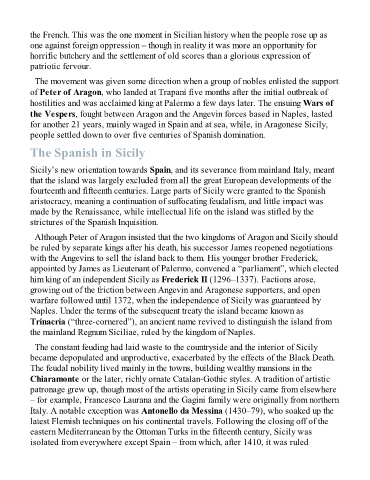Page 568 - The Rough Guide of Sicily
P. 568
the French. This was the one moment in Sicilian history when the people rose up as
one against foreign oppression – though in reality it was more an opportunity for
horrific butchery and the settlement of old scores than a glorious expression of
patriotic fervour.
The movement was given some direction when a group of nobles enlisted the support
of Peter of Aragon, who landed at Trapani five months after the initial outbreak of
hostilities and was acclaimed king at Palermo a few days later. The ensuing Wars of
the Vespers, fought between Aragon and the Angevin forces based in Naples, lasted
for another 21 years, mainly waged in Spain and at sea, while, in Aragonese Sicily,
people settled down to over five centuries of Spanish domination.
The Spanish in Sicily
Sicily’s new orientation towards Spain, and its severance from mainland Italy, meant
that the island was largely excluded from all the great European developments of the
fourteenth and fifteenth centuries. Large parts of Sicily were granted to the Spanish
aristocracy, meaning a continuation of suffocating feudalism, and little impact was
made by the Renaissance, while intellectual life on the island was stifled by the
strictures of the Spanish Inquisition.
Although Peter of Aragon insisted that the two kingdoms of Aragon and Sicily should
be ruled by separate kings after his death, his successor James reopened negotiations
with the Angevins to sell the island back to them. His younger brother Frederick,
appointed by James as Lieutenant of Palermo, convened a “parliament”, which elected
him king of an independent Sicily as Frederick II (1296–1337). Factions arose,
growing out of the friction between Angevin and Aragonese supporters, and open
warfare followed until 1372, when the independence of Sicily was guaranteed by
Naples. Under the terms of the subsequent treaty the island became known as
Trinacria (“three-cornered”), an ancient name revived to distinguish the island from
the mainland Regnum Siciliae, ruled by the kingdom of Naples.
The constant feuding had laid waste to the countryside and the interior of Sicily
became depopulated and unproductive, exacerbated by the effects of the Black Death.
The feudal nobility lived mainly in the towns, building wealthy mansions in the
Chiaramonte or the later, richly ornate Catalan-Gothic styles. A tradition of artistic
patronage grew up, though most of the artists operating in Sicily came from elsewhere
– for example, Francesco Laurana and the Gagini family were originally from northern
Italy. A notable exception was Antonello da Messina (1430–79), who soaked up the
latest Flemish techniques on his continental travels. Following the closing off of the
eastern Mediterranean by the Ottoman Turks in the fifteenth century, Sicily was
isolated from everywhere except Spain – from which, after 1410, it was ruled

